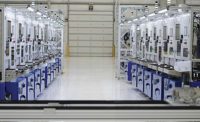Through the first six months of 2023, U.S. sales of light vehicles topped 7.68 million units, an increase of 13 percent compared with the first six months of 2022, according to market research firm GlobalData. Depending on the outcome of the UAW’s strike against the Detroit Three automakers, sales for the year could range from 15.1 million to 15.4 million units, an increase of 9 to 11 percent over last year.
If that holds true, automakers will need more than 61 million wheels this year, and that doesn’t count aftermarket replacements and upgrades. That’s a lot of wheels.
Satisfying that kind of demand requires automation. Hyperion Automation of Holland, MI, knows all about it. Recently, the systems integrator designed and built an automated packing cell for a wheel manufacturer.
Automation was necessary in the wake of several challenges. Labor shortages made it difficult to find and retain talent for the packing line, which ran around the clock. The wheels were heavy. Without the tire, a metal wheel typically weighs 30 pounds. Moving them from the end of the processing line to packing line required strength and care—while still maintaining the throughput rate.
However, automating the cell would not be easy. For one thing, different wheels required different pallets, dividers and protective polyfoam sheets. The system’s robots and conveyors would need to be precise, but flexible enough to handle all types of materials.
Space was also a concern. The shop floor only had so much space to house automation. The cells had to be large enough to allow access for employees to add new pallets and materials with fork trucks or perform maintenance on the machines.
The packing cell required numerous interface points. Space was needed for fork trucks to get in and out; operators to move rejected wheels and pallets out of the cell; operators to move 48-inch polyfoam rolls into the cell; operators to maintain the robots; and empty pallets and newly finished wheels to come in via conveyors.
Hyperion’s cell meets all these requirements. A roller conveyor transports wheels from the production lines to the packing cell. A second roller conveyor moves loaded pallets out of the cell to shipping. The conveyors are designed to transport all sizes of wheels, pallets and dunnage. The conveyor uses pallet stops to align the pallet along the front edge of the cell. A “crowder” mechanism pushes it into alignment on the side.
A six-axis robot handles wheels of every size and weight. The robot gently picks up a wheel from a conveyor and places it accurately on a pallet at a consistent rate.
As wheels pass through the initial conveyor, a vision system scans the wheels to verify wheel size and type, ensuring consistency and correct packaging materials.
A second vision system guides the robots, identifying divider types as they convey into the cell. The vision system then scans the entire pallet to verify the correct dunnage type for the wheels being loaded, while also capturing positional data on X, Y, Z and angular offsets to successfully pick and place each divider. The system prevents the wrong dividers or bases from being used.
A polyfoam sheeter automatically cuts the material to length on demand. This saves on the cost of precut material and the labor required to manually place the sheets between rows of wheels. The automated sheeter can also switch sheet size on demand to accommodate five to eight pallet sizes.
In the final step of the process, the pallet is conveyed out of the cell and into an automated bander system. Previously, the banding machine required an operator to line up the pallet and then push a button to band it. The new fully automated machine completes the work without the need for an additional worker.
To see a video of the system in operation, click here. For more information on automation, visit the company’s website: https://hyperionautomation.com.
For more information on assembly automation, read these articles:
Robots Assembly Medical Device on Rotary Indexers
Robots Automate Assembly of Auto Parts
Ten Tips for Automated Assembly of Medical Devices





